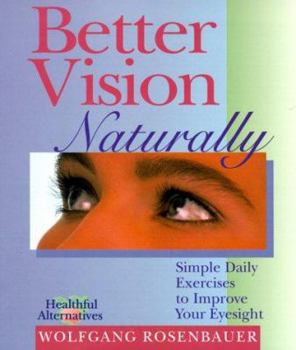Better Vision Naturally: Simple Daily Exercises to Improve Your Eyesight
Select Format
Select Condition 
Book Overview
Get better vision the revolutionary all-natural way, with short and simple exercises; changing your lighting; altering the way you read a book or the computer; even exercising. Whether your eyes are 20/20 and you want to keep them that way, or whether you want to restore lost vision, there's lots here to enlighten you.
Format:Paperback
Language:English
ISBN:0806999810
ISBN13:9780806999814
Release Date:June 1998
Publisher:Sterling
Length:196 Pages
Weight:0.53 lbs.
Dimensions:0.3" x 6.9" x 8.0"
Customer Reviews
1 rating
Very useful holistic manual for better vision
Published by Thriftbooks.com User , 24 years ago
I must disagree with some of the previous reviewers who have said this book is a "farce." It is not a farce. It is based on a wide variety of vision improvement techniques, including the Bates method, behavioral optometry, yoga, color therapy, acupressure, massage, etc. It presents many different types of "vision training," eye exercises, and other therapies. I do think it could be better organized. The chapters included are: 1. Introduction - in which the author explains what eye training is; 2. Vision and Eye training today - in which he explains that it is preventative medicine, and that glasses and contacts are not necessarily the answer to vision problems; 3. Understanding vision; 4. The basics of eye training - explaining that we should establish physical and visual habits that promote healthy vision; 5. Holistic Eye Training - explaining that we see with our whole body, that our vision is more than just in our eyes, that we need to consciously participate in what we see; 6. Eye training in 5 Lessons -- the lessons include eye relaxation, refreshing and strengthening eyesight, eye movement, accommodation, spatial perception and visual memory; 7. Healthy Tips for the Eyes -- which include vitamins for good vision, eye showers, eye baths, using eye pillows, acupressure, and using light; 8. Disadvantages of visual aids -- in which the author discusses why we should try to take off our glasses when we do not need them, and/or use weaker glasses or progressive undercorrection to allow an improvement in our vision, and he also talks about pinhole glasses; 9. Eye training with posters/Exercising your perception of contrast -- to increase visual perception, to train the external eye muscles, to exercise near vision, to aid stereoscopic vision (3D posters), and to increase visual memory; 10. Short Exercises for Lively Vision -- a chapter with 20 quick exercises that can be done in a few minutes. The exercises are based on what was covered throughout the book. This chapter also includes "8 steps to success."The book is not organized terribly well, and apart from the 20 quick exercises routine at the end, there aren't many tips on how to design your own program. But for a nice overview of different visual therapy techniques for natural vision improvement, this book does a good job. There are lots of color plates and it is printed on nice heavy stock. The author likes to emphasize that these exercises are not just for those with "defective" vision, but also (and even more so) for those with "perfect" vision, in order to prevent vision problems that seem to come inevitably to just about everyone. One thing I did not like about the book is that on the back of the book, it says, "Whether your eyes are 20/20 and you want to keep them that way, or whether you want to restore lost vision, here are all the methods you'll need to do it." But then in one of the first sections, it says, "people with defective vision should know that the eye training program






